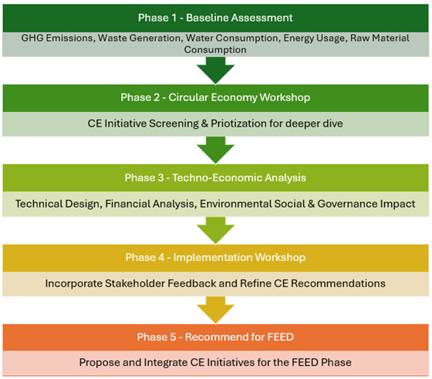October 2025
Sustainability and the Energy Transition
Circular economy for the SASREF refinery expansion project SASREF+: Alignment with the Saudi Green Initiative
The integration of circular economy (CE) principles into petrochemical megaprojects is rapidly emerging as a strategic imperative for sustainable industrial development. This article presents a case study from the SASREF+ project, a world-scale petrochemical complex in Jubail, Saudi Arabia, where CE initiatives were evaluated and prioritized through a structured workshop and techno-economic analysis. These initiatives span water reuse, polymer recycling, solar energy deployment, green construction materials and advanced automation technologies. Each initiative aligns with Saudi Aramco’s CE strategies and Vision 2030 goals, demonstrating how CE-driven design can reduce environmental impact, optimize resource utilization and enhance long-term economic performance. The study provides actionable insights for integrating CE into front-end engineering design (FEED) and engineering, procurement and construction (EPC) phases, offering a replicable framework for future capital projects in the hydrocarbon sector.
Sustainability visual framework. The global petrochemical industry is undergoing a paradigm shift as sustainability, resource efficiency and climate resiliency become central to project development. In response to these challenges, Saudi Aramco has adopted a CE framework to guide its capital projects, aiming to transition from linear resource consumption models to regenerative, closed-loop systems.
The SASREF+ project1, located in the Jubail II Industrial Area, is a flagship initiative within Aramco’s Liquid-to-Chemicals (LTC) program. Designed to convert 187 MMft3d of ethane into high-value polymer derivatives, the complex includes an ethane cracker, polyethylene units, propylene recovery, and associated utilities and offsites, collectively called the Ethane Cracker Complex (ECC). FIG. 1 provides a comprehensive visual framework that illustrates how Saudi Aramco’s sustainability strategy is holistically aligned with both Saudi Arabia’s Vision 2030 and the United Nations’ (UN’s) Sustainable Development Goals (SDGs).2,3

FIG. 1. Sustainability visual framework showing alignment of Saudi Aramco’s sustainability focus with Saudi Vision 2030 and the UN’s SDGs. Source: Saudi Aramco’s Sustainability Report 2024.
At the center of the diagram is the core operational philosophy “How we work,” anchored by strong governance. Radiating outward are four key sustainability focus areas: Climate change and the energy transition, safe operations and people development, minimizing environmental impact and growing societal value. Each of these pillars is supported by targeted sustainability initiatives such as energy efficiency, circular carbon economy, digital infrastructure development and renewable energy deployment. These initiatives are then mapped to specific SDGs, including SDG 7 (affordable and clean energy), SDG 9 (industry, innovation and infrastructure), SDG 12 (responsible consumption and production) and SDG 13 (climate action), among others. The circular layout of FIG. 1 reinforces the interconnected nature of Aramco’s sustainability efforts, emphasizing that environmental stewardship, social responsibility and economic resilience are not isolated goals but rather part of a unified strategy.
This article serves as a foundational roadmap for the SASREF+ CE, demonstrating how each CE initiative—as a part of the project execution plan—contributes to the broader national and global sustainability objectives.
CE framework and roadmap. Saudi Aramco’s CE strategy is built upon seven foundational principles designed to transform resource use, asset design and operational practices across its capital projects. These principles include:
- Design for a CE
- Build CE supply chains
- Foster sustainable environmental practices
- Preserve and extend material and asset lifecycle
- Utilize regenerative and renewable resources
- Turn waste into resources
- Adopt innovative technologies and digitalization.
CE integration roadmap. The SASREF+ CE study followed a structured five-phase roadmap to identify, evaluate and prepare CE initiatives for implementation in the FEED phase, as shown in FIG. 2. This roadmap ensured that sustainability was embedded in the SASREF+ project from the early phases of the project, i.e., from conceptual feasibility through the FEED phase.

FIG. 2. CE integration roadmap for the SASREF+ project.
- Phase 1: Baseline assessment. The study began with a comprehensive review of the SASREF+ complex’s projected emissions and resource consumption for the ECC. This included water usage, energy demand, waste generation and material flows. The baseline provided a reference point for evaluating the potential impact of CE initiatives and aligning them with Saudi Aramco’s sustainability targets and the UN’s SDGs.
- Phase 2: CE workshop. As a part of the CE roadmap, the co-author’s company conducted a CE workshop in April 2025 at its Houston, Texas (U.S.) office, bringing together subject matter experts from both companies to prescreen more than 140 CE ideas. The workshop applied a structured evaluation methodology based on technical feasibility, economic viability, environmental impact and alignment with the project’s CE goals.
- Phase 3: Techno-economic analysis. Each selected initiative underwent a detailed techno-economic evaluation. These included:
- Cost estimates
- Financial and sensitivity analyses
- An environmental, social and governance (ESG) impact assessment
- A risk assessment.
The analyses provided a decision-making framework for prioritizing CE initiatives based on both sustainability and financial performance.
- Phase 4: Implementation workshop. An implementation workshop reviewed key findings, addressed stakeholder feedback and refined CE recommendations. The workshop served as a critical bridge between concept validation and project consideration, ensuring that CE initiatives are technically sound, strategically aligned and ready for design development.
- Phase 5: Project integration. The final CE recommendations were structured to support consideration and evaluation for the FEED phase. Each initiative included a design basis, preliminary sizing and cost estimates to enable further development by the FEED engineering contractor. This ensured that CE principles were embedded into the final design, procurement and execution strategy for the SASREF+ complex.
Results and discussion. The list of selected CE initiatives is shown in TABLE 1. These CE initiatives span diverse domains, from water and energy to materials and automation, and were mapped to specific CE strategies to ensure strategic coherence.

Water reuse and recovery: Enabling circular water management. Within the SASREF+ complex, the CE study identified water reuse as a strategic opportunity to reduce the reliance on desalinated water, minimize wastewater discharge and enhance overall resource efficiency.
The water reuse CE initiative is projected to reduce freshwater consumption, lower discharge volumes and improve the facility’s carbon footprint, contributing to an estimated annual revenue of $1.25 MM and a discharge cost reduction of $610,000. The polymer pellet water recycle CE initiative expects to deliver 90% reuse of wastewater generated during polymer production, delivering an estimated $723,000/yr in margin improvement.
Circular water management aligns strongly with the objectives of the Saudi Green Initiative (SGI), which emphasizes reducing emissions, conserving natural resources and promoting responsible consumption. It also contributes to key UN SDGs, including SDG 6 (clean water and sanitation), SDG 12 (responsible consumption and production) and SDG 13 (climate action).
The reuse strategy proposed in the study reflects a shift from conventional linear water use models to regenerative systems that retain water value within the facility. This approach not only enhances environmental performance but also positions SASREF+ as a model for sustainable petrochemical development in the region.
Solar power: Advancing renewable energy integration. The deployment of solar photovoltaic systems across the SASREF+ complex represents a transformative step toward decarbonizing industrial energy use. By leveraging available rooftops, parking lots and open land parcels, the project aims to generate 68,000 MWh/yr of clean electricity that will offset fossil fuel consumption and reduce greenhouse gas (GHG) emissions by 710,000 metric tons of avoided carbon dioxide equivalent (CO2e) over the project’s life. These figures are based on a preliminary cogeneration model developed early in the study, underscoring the substantial environmental impact of distributed solar generation within a petrochemical setting.
This initiative directly supports the SGI’s ambition to increase Saudi Arabia’s renewable energy capacity and reduce carbon footprint. It demonstrates how petrochemical facilities can integrate solar energy into operations without compromising reliability or safety. It also contributes to key national and international goals, including SDG 7 (affordable and clean energy), SDG 13 (climate action) and Saudi Arabia’s Vision 2030 targets for clean energy transition.
The SASREF+ solar strategy exemplifies how industrial projects can move beyond compliance toward leadership in sustainability, setting a precedent for future developments in the region.
Plastics recycling: Closing the loop on industrial waste. Plastic waste management is a critical challenge for petrochemical facilities, particularly those involved in polymer production. The SASREF+ CE study identified plastic recycling as a high-impact opportunity to convert post-industrial and post-consumer plastic waste into valuable hydrocarbon feedstock through advanced technologies such as pyrolysis and hydrothermal treatment.
This initiative aligns with the SGI’s goals to reduce landfill dependency, promote resource circularity and foster innovation in waste-to-value technologies. By transforming plastic waste into reusable inputs for chemical production, the project supports a closed-loop system that minimizes environmental impact and maximizes material recovery.
The study evaluated multiple technology pathways and vendor solutions, emphasizing modularity, feedstock flexibility and integration potential within the SASREF+ complex. It also highlighted the importance of local recycling ecosystems and partnerships with regional recyclers to strengthen supply chains and reduce transportation emissions.
Plastic recycling at SASREF+ contributes to SDG 12 (responsible consumption and production) and SDG 9 (industry, innovation and infrastructure), while reinforcing Saudi Aramco’s commitment to sustainable manufacturing and circular design. It demonstrates how petrochemical assets can evolve from waste generators to resource regenerators, driving both environmental and economic value.
Green concrete. The adoption of green concrete within the SASREF+ project reflects a strategic alignment with the broader objectives of the SGI, which aims to reduce carbon emissions, promote sustainable construction practices and accelerate the Kingdom’s transition to a CE. By incorporating industrial byproducts such as fly ash, slag and recycled aggregates into concrete formulations, the project demonstrated a commitment to lowering the environmental footprint of infrastructure development without compromising performance or durability.
Green concrete offers a pathway to decarbonize one of the most resource-intensive aspects of petrochemical construction. Its use supports the reduction of embodied carbon, enhances thermal efficiency and contributes to long-term sustainability across the asset lifecycle. Moreover, the initiative reinforces Saudi Aramco’s leadership in environmental stewardship by showcasing how innovative materials can be integrated into large-scale industrial projects in compliance with national standards like the Saudi Green Building Code (SBC 1001).
The findings from the SASREF+ CE study demonstrated that green concrete is not only technically viable but also socially and environmentally beneficial. It strengthens the ESG profile of the project, aligns with Vision 2030 goals and sets a precedent for future developments seeking to balance economic growth with ecological responsibility.
Circular supply chains and responsible sourcing. The SASREF+ project highlights the strategic importance of building circular supply chains within the petrochemical sector. By shifting from traditional linear procurement models to systems that prioritize local sourcing, material reuse and supplier sustainability, the project aligns with the Saudi Arabia’s broader goals under the SGI and Vision 2030. The evaluation of raw material suppliers included environmental performance, lifecycle impact and circularity metrics, ensuring that procurement decisions support long-term resource efficiency and emissions reduction.
Initiatives such as responsible sourcing of raw materials, the rejuvenation of spent chemicals and the use of eco-friendly construction materials demonstrated how supply chain decisions can directly influence a project’s environmental footprint. Moreover, the integration of supplier evaluation frameworks based on transparency, certifications and circularity indicators sets a precedent for future projects. These efforts not only reduced embodied carbon and waste but also strengthened regional industrial ecosystems and promoted innovation in sustainable manufacturing.
By embedding circularity into the supply chain, SASREF+ reinforces the role of procurement as a driver of sustainability, transforming it from a transactional function into a strategic enabler of environmental and economic performance.
Advanced automation and robotics for sustainable operations. The SASREF+ project’s consideration of advanced automation technologies (FIG. 3), including autonomous warehouse systems and robotic leak detection, demonstrates a transformative shift toward intelligent, low-carbon industrial operations. These initiatives are emblematic of Saudi Aramco’s commitment to digitalization, operational excellence and environmental stewardship, and they directly support the objectives of the SGI to reduce emissions and modernize infrastructure.

FIG. 3. Infographic showing the benefits of using robots for leak detection (left) and warehouse automation (right).
Automated pallet handling systems in the polymer packaging warehouses reduce reliance on manual labor, optimize energy use and enhance safety. By integrating smart routing, predictive maintenance and real-time inventory tracking, the facility moves toward a digitally enabled circular logistics model.
Similarly, the use of ground robots for leak detection introduces a proactive approach to emissions management. These autonomous systems can perform frequent inspections, identify fugitive emissions early and reduce the risk of environmental incidents while minimizing human exposure to hazardous areas.
Together, these technologies represent a scalable blueprint for sustainable industrial automation. They not only improve operational efficiency and reduce lifecycle costs, but also contribute to decarbonization, workforce upskilling and safer working environments. By embedding automation into the design and execution of SASREF+, the project set a precedent for future petrochemical developments seeking to align with national sustainability goals and global best practices.
4Rs: Reduce, reuse, recycle and remove. While the SASREF+ project successfully identified and evaluated multiple CE initiatives, the implementation of the foundational principles of reduce, reuse, recycle and remove presented notable challenges in complex industrial environments. These principles require a shift not only in technology and design but also in mindset, operations and supply chain coordination. For example, reducing resource consumption often conflicts with legacy design standards and throughput expectations, while reuse strategies may be constrained by material compatibility, regulatory compliance or safety concerns.
Recycling within petrochemical facilities demands robust segregation, treatment and reintegration systems, which can be capital-intensive and operationally complex. Regeneration, particularly of chemicals and catalysts, requires specialized vendor engagement and clear performance guarantees that may not be readily available in all regions. Moreover, aligning these principles with existing procurement, maintenance and turnaround practices requires cross-functional collaboration and long-term planning.
Despite these challenges, the SASREF+ study demonstrated that with early integration, stakeholder alignment and a phased implementation strategy, these principles can be operationalized effectively. The key lies in balancing innovation with practicality, ensuring that sustainability measures are not only aspirational but also executable within the constraints of large-scale industrial projects.
Lessons learned for the petrochemical industry. The SASREF+ CE study offered valuable insights into the broader petrochemical sector, particularly in how sustainability can be systematically embedded into capital project development. One of the key lessons learned is the importance of integrating CE principles early, starting from baseline emissions assessment and continuing through design, technology selection and stakeholder engagement. This proactive approach enables the identification of high-impact opportunities that are both environmentally and economically viable.
The study also highlighted the effectiveness of structured workshops and cross-functional collaboration in screening and prioritizing CE initiatives. By combining technical expertise with strategic alignment, organizations can ensure that sustainability measures are aspirational as well as actionable. Furthermore, the use of techno-economic analysis as a decision-making tool reinforces the need to balance environmental benefits with financial performance, making CE integration more compelling for project sponsors and investors.
Lastly, the SASREF+ experience underscored the value of digitalization and automation not just as operational enhancements, but as enablers of circularity. Technologies such as robotic inspection, smart logistics and advanced materials management can significantly reduce emissions, improve safety and support long-term asset resilience.
These lessons are broadly applicable to other petrochemical projects seeking to align with national sustainability goals, global ESG standards and the evolving expectations of stakeholders across the value chain.
Recommendations.
- Embed CE principles into capital projects by adopting a CE roadmap, ensuring alignment with national sustainability goals and global ESG standards.
- Prioritize initiatives with dual value that offer both environmental impact and economic return, such as automation, energy recovery and material reuse.
- Engage local suppliers and recyclers to support CE implementation, foster innovation and strengthen regional CE ecosystems.
- Leverage digital tools and smart technologies to enhance monitoring, predictive maintenance and resource optimization across operations.
- Continue refining CE initiatives during FEED and EPC phases, incorporating detailed cost estimates, vendor engagement and regulatory compliance to ensure successful execution.
By integrating CE strategies into the design and development of SASREF+, Saudi Aramco set a benchmark for sustainable industrial growth, one that can be replicated across the petrochemical sector and beyond.
Takeaways. The SASREF+ CE study demonstrated how sustainability can be systematically embedded into the lifecycle of a petrochemical megaproject. By following a structured roadmap from baseline assessment to FEED integration, the project has successfully identified and evaluated a diverse portfolio of CE initiatives that align with Saudi Aramco’s strategic goals and the broader objectives of the SGI.
Key findings show that initiatives such as green concrete, advanced warehouse automation and robotic leak detection are not only technically feasible, but also offer long-term environmental, social and economic benefits. These technologies support decarbonization, resource efficiency and digital transformation, while enhancing safety and operational resilience.
The study reinforced the importance of early stakeholder engagement, cross-functional collaboration and data-driven decision-making in CE implementation. It also highlighted the value of evaluating CE for the FEED phase to ensure that sustainability is not an afterthought, but a core design principle.
ACKNOWLEDGEMENT
The UN SDG icons are taken from https://www.un.org/sustainabledevelopment/. The content of this publication has not been approved by the United Nations and does not reflect the views of the UN or its officials or Member States.
LITERATURE CITED
1 Saudi Aramco, “Aramco, Rongsheng Petrochemical Co. sign agreement to expand SASREF,” Aramco Life, November 19, 2024, online: https://www.aramcolife.com/en/publications/the-arabian-sun/articles/2024/week-47/aramco-sasref-expansion-framework-agreement
2 Kingdom of Saudi Arabia, “Vision 2030: Saudi Green Initiative,” online: www.vision2030.gov.sa/en/explore/projects/saudi-green-initiative
3 UN, “Sustainable devleopment goals,” Department of Economic and Social Affairs, Sustainable Development, online: https://sdgs.un.org/goals












Comments